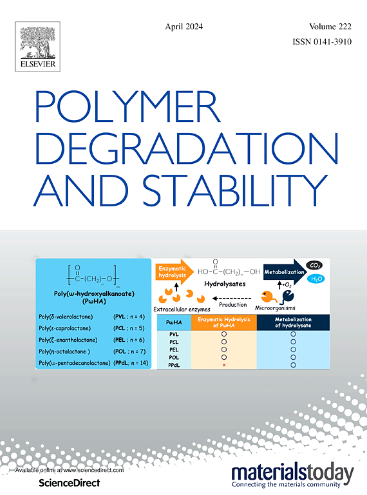了解耐高温加成固化液体硅橡胶的成分属性关系:综述
IF 6.3
2区 化学
Q1 POLYMER SCIENCE
引用次数: 0
摘要
随着航空航天、电子和交通运输等行业的快速发展,各领域对耐高温加成固化液体硅橡胶(ALSR)的需求不断激增。然而,ALSR 结构与性能之间的复杂关系仍不清楚。因此,本研究旨在全面回顾 ALSR 的最新研究进展。具体而言,本研究涉及硅橡胶的热降解行为;全面综述耐高温 ALSR 的四种成分,包括基本聚合物、交联剂、填料和催化剂;阐明每种成分与耐热性能之间的关系;以及应对耐高温 ALSR 的未来挑战。本综述为耐高温 ALSR 的设计提供了宝贵的见解。本文章由计算机程序翻译,如有差异,请以英文原文为准。
An understanding of component-properties relationship of high-temperature resistant addition-cure liquid silicone rubber: A review
The demand for addition-cure liquid silicone rubber (ALSR) with high temperature resistance in various fields is continuously surging, propelled by the rapid advancement of industries such as aerospace, electronics, and transportation. However, the intricate relationship between the structure and performance of ALSR remains unclear. Therefore, this present study aims to conduct a comprehensive review of recent research advancements in ALSR. More specifically, it pertains to the thermal degradation behavior of silicone rubber; providing a comprehensive review of four components in high-temperature resistant ALSR, including basic polymers, crosslinking agents, fillers, and catalysts; elucidating the relationship between each component and heat resistance properties; as well as addressing the future challenges about high-temperature resistant ALSR. This review provides valuable insights into the design of a high-temperature resistant ALSR.
求助全文
通过发布文献求助,成功后即可免费获取论文全文。
去求助
来源期刊

Polymer Degradation and Stability
化学-高分子科学
CiteScore
10.10
自引率
10.20%
发文量
325
审稿时长
23 days
期刊介绍:
Polymer Degradation and Stability deals with the degradation reactions and their control which are a major preoccupation of practitioners of the many and diverse aspects of modern polymer technology.
Deteriorative reactions occur during processing, when polymers are subjected to heat, oxygen and mechanical stress, and during the useful life of the materials when oxygen and sunlight are the most important degradative agencies. In more specialised applications, degradation may be induced by high energy radiation, ozone, atmospheric pollutants, mechanical stress, biological action, hydrolysis and many other influences. The mechanisms of these reactions and stabilisation processes must be understood if the technology and application of polymers are to continue to advance. The reporting of investigations of this kind is therefore a major function of this journal.
However there are also new developments in polymer technology in which degradation processes find positive applications. For example, photodegradable plastics are now available, the recycling of polymeric products will become increasingly important, degradation and combustion studies are involved in the definition of the fire hazards which are associated with polymeric materials and the microelectronics industry is vitally dependent upon polymer degradation in the manufacture of its circuitry. Polymer properties may also be improved by processes like curing and grafting, the chemistry of which can be closely related to that which causes physical deterioration in other circumstances.
 求助内容:
求助内容: 应助结果提醒方式:
应助结果提醒方式:


